Hello,
Long story short I suspect tilting back speakers about measly 10 degrees give or take would positively affect imaging.
This is a thread where it would be nice to collect some observations and experiences on tilting back loudspeakers, is it worth it.
Without further ado I'll explain an observation I had recently from VituixCAD simulation and I'd like to know better what you have experienced in terms of sound stage height and / or stability with and without tilt. If you have any comments regarding vertical early reflections and speaker tilt and height, crossovers, how we perceive the vertical reflections, what ever related.
There are attachments after the longish text explanation, scroll back and worth, it was bit hard to condense.
Observation from simulations:
Multiway speaker will have narrowing vertical response around crossover frequency on most typical two(+) way speakers between a tweeter and a woofer due to the drivers being not coincident but stacked one above the other, lobing. With symmetric crossover this narrowing is symmetric to vertical angles relative to listening axis meaning that above and below listening axis the frequency response is roughly similar 10 and -10, 20 and -20 etc.
On a typical listening situation a loudspeaker is positioned so that listening axis is about at ear height which is 90cm from floor in this example. Usually rooms (here in Finland at least) are about 2.5m tall and listening distance is 3m. Due to speaker and listeners ears being closer to floor than to ceiling angles towards first vertical specular reflections differ between floor and ceiling. On this example scenario the angles are roughly 30 degrees towards floor specular reflection and about 50 degrees towards ceiling. This means that with symmetric crossover frequency response towards these reflections are different. Also, floor being closer the path length through the floor is shorter than through the ceiling and this means less attenuation through floor reflection, which is louder of the two and arrives first to ear, right after direct sound making it probably dominant of the two.
Now the hypothesis from this observation regards to "vertical imaging" is that due to differing frequency responses that arrive to ear from high up and down below, and particularly nasty zigzag move right around crossover point which usually is right at the important vocal range and where ear is sensitive, affects perceived vertical image height/soundstage clarity/how would you call it. This is something I think I heard with quick listening test and would like to know what you think and hear.
Tilting speaker back some 10-15 degrees on this example scenario will make the response towards the first reflection points similar, no zig zag move and highs towards ceiling get boost and respectively attenuation towards floor. Same thing happens with my prototype speaker. I assume but don't know if its true, that if there is more sound through floor than through ceiling, and especially since the floor reflection arrives earlier, the perceived sound image height stays low. The zig zag move perhaps makes important vocal range image little bit hazy because there is more sound towards floor in general except around the crossover there is suddenly more sound to ceiling which perhaps pulls up this frequency zone a bit in perceived image, a confusing thing. When the two reflections are roughly balanced I assume sound image is stable at the speaker height, less confusing perceived vertical image. In addition if there was more highs through ceiling and more lows through floor would possibly elongate perceived vertical image some. If you know better or have links to studies, please comment!
This makes a lot of sense to me logically and I think I heard it but not so sure if its just bias 😀 Keep in mind direct sound frequency response also changes as speaker is tilted, but this could be adjusted if the scenario is planned in design phase. I'd be glad if you can share thoughts on it and especially if you have tried it. did vertical image or image in general get somehow sharper and perhaps even taller?
Here are some attachments for the text above.
This is made up sim with ideal drivers, its a two way box with 5" woofer and 1" tweeter, 20cm wide and 31cm tall, rather typical bookshelf speaker. The situation would be about the same for any loudspeaker that has a small tweeter and a woofer who are not coincident but stacked one above the other, perhaps 90% of all speakers out there, could be two or more ways, bookshelf or tower. Speaker with coincident tweeter and woofer (or a fullrange driver, or an array etc.) would have pretty much similar frequency response towards these reflections and perhaps there is not much difference. Perhaps this is partly the reason people like such speakers?
Drivers and baffle, responses made with mic at center for simplicity.
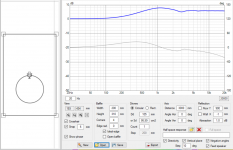
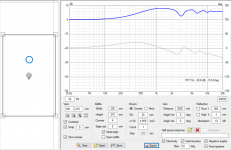
Here is the basic simple simulation setup. Arbitrary crossover point at 2500Hz, could be more or less doesn't matter, this is just some plausible crossover for such system.
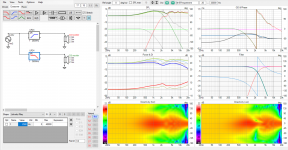
Angle calculations, the room setup and simple right angle triangle calculator to get how much I need to increase tweeter Z coordinate with the Tilt angle in simulator. On the calculator B was set to driver c-c distance of 10cm and desired angle to alpha. This is not too accurate do it like so but accurate enough to zone in the tilt for listening experiment.
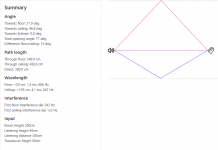
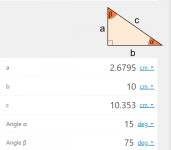
Here is the angles visible illustrating zig zag. Bottom graph shows -30 angle towards floor, direct sound and +50 angle towards ceiling. The zig zag happens roughly between 2-5kHz in this example, when ceiling reflection is relatively louder than floor reflection ( I think these graphs don't include attenuation due to path length ). Same graphs are also in power and DI window as light blue and light brown, these are default in VituixCAD so one doesn't have to setup the user defined angle if you are checking the stuff out in your project.
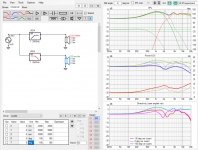
Now with small 10 degree tilt we can align the floor and ceiling reflection responses better so that dip due to lobing on both reflections happens roughly at same frequency. The hypothesis was that now both floor and ceiling reflections are about as loud through the whole frequency spectrum keeping the vertical image more stationary, stable. Alignment is not perfect but there is about no zig zag. 15 degrees would work fine as well but in the example listening axis response suffers already quite much. I don't know how bad this would be with your speaker, perhaps affects perceived sound or not.
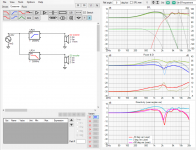
Here is also 15 and 20 degree tilts. 20 degrees is too much in this case, zig zag is worse.
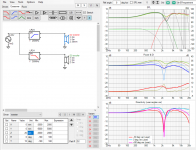
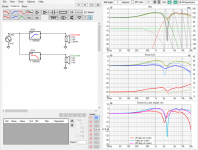
And here is completely another kind of system a three way with waveguide based on real measurements, not sure what kind of crossover slopes are, symmetric enough at least to make the zig zag. See the ER lines, light blue and brown. The first image is system adjusted before checking out this stuff, for basically power and DI and that kind of stuff. The second image shows that if I was to sacrifice some of the other lines and just adjust delay of the system to get tweeter back some and steer the nulls toward reflection angles the zig zag is gone. Not much of a sacrifice because the response can be adjusted for this new delay. Third image also tilts the waveguide little, now there is relatively more sound through ceiling on high frequencies than through floor, similar thing than perhaps a thick rug does as well. As frequency goes up more from above and less sound below listening axis. Here the 10 degree tilt works just fine.



I suspect your speakers and listening setup are suitable for the test. If you try tilting your speakers I suggest you to concentrate on vocals when listening for the effects of tilting but anything goes. What do you hear or is there any difference at all on sound image?
Here are some quick rough numbers to tilt your speaker roughly 10 degrees, put some Lego (a standard block is ~1cm high) or something else under front edge of your speaker. You could try more or less tilt if you wish. Careful not to tip over your speakers, I don't want to be held responsible for broken stuff! 🙂 If you have DSP you could just delay the tweeter (driver closest to ceiling) some extra to tilt the nulls instead of physically tilting the speaker.
Box depth affects how high the front edge needs to be lifted to achieve 10 degree tilt. Here is few for starters:
20cm deep speaker box use ~5cm riser on the front, 5 lego blocks.
30cm deep speaker box use ~7cm riser.
40cm deep speaker box use ~10cm riser.
50cm deep speaker box use ~13cm riser.
ps. I'm sorry we have people coming in for visit so I might not be able to comment extensively too much until weekend. I hope the text is extensive enough to get an idea and comments flowing 🙂
Long story short I suspect tilting back speakers about measly 10 degrees give or take would positively affect imaging.
This is a thread where it would be nice to collect some observations and experiences on tilting back loudspeakers, is it worth it.
Without further ado I'll explain an observation I had recently from VituixCAD simulation and I'd like to know better what you have experienced in terms of sound stage height and / or stability with and without tilt. If you have any comments regarding vertical early reflections and speaker tilt and height, crossovers, how we perceive the vertical reflections, what ever related.
There are attachments after the longish text explanation, scroll back and worth, it was bit hard to condense.
Observation from simulations:
Multiway speaker will have narrowing vertical response around crossover frequency on most typical two(+) way speakers between a tweeter and a woofer due to the drivers being not coincident but stacked one above the other, lobing. With symmetric crossover this narrowing is symmetric to vertical angles relative to listening axis meaning that above and below listening axis the frequency response is roughly similar 10 and -10, 20 and -20 etc.
On a typical listening situation a loudspeaker is positioned so that listening axis is about at ear height which is 90cm from floor in this example. Usually rooms (here in Finland at least) are about 2.5m tall and listening distance is 3m. Due to speaker and listeners ears being closer to floor than to ceiling angles towards first vertical specular reflections differ between floor and ceiling. On this example scenario the angles are roughly 30 degrees towards floor specular reflection and about 50 degrees towards ceiling. This means that with symmetric crossover frequency response towards these reflections are different. Also, floor being closer the path length through the floor is shorter than through the ceiling and this means less attenuation through floor reflection, which is louder of the two and arrives first to ear, right after direct sound making it probably dominant of the two.
Now the hypothesis from this observation regards to "vertical imaging" is that due to differing frequency responses that arrive to ear from high up and down below, and particularly nasty zigzag move right around crossover point which usually is right at the important vocal range and where ear is sensitive, affects perceived vertical image height/soundstage clarity/how would you call it. This is something I think I heard with quick listening test and would like to know what you think and hear.
Tilting speaker back some 10-15 degrees on this example scenario will make the response towards the first reflection points similar, no zig zag move and highs towards ceiling get boost and respectively attenuation towards floor. Same thing happens with my prototype speaker. I assume but don't know if its true, that if there is more sound through floor than through ceiling, and especially since the floor reflection arrives earlier, the perceived sound image height stays low. The zig zag move perhaps makes important vocal range image little bit hazy because there is more sound towards floor in general except around the crossover there is suddenly more sound to ceiling which perhaps pulls up this frequency zone a bit in perceived image, a confusing thing. When the two reflections are roughly balanced I assume sound image is stable at the speaker height, less confusing perceived vertical image. In addition if there was more highs through ceiling and more lows through floor would possibly elongate perceived vertical image some. If you know better or have links to studies, please comment!
This makes a lot of sense to me logically and I think I heard it but not so sure if its just bias 😀 Keep in mind direct sound frequency response also changes as speaker is tilted, but this could be adjusted if the scenario is planned in design phase. I'd be glad if you can share thoughts on it and especially if you have tried it. did vertical image or image in general get somehow sharper and perhaps even taller?
Here are some attachments for the text above.
This is made up sim with ideal drivers, its a two way box with 5" woofer and 1" tweeter, 20cm wide and 31cm tall, rather typical bookshelf speaker. The situation would be about the same for any loudspeaker that has a small tweeter and a woofer who are not coincident but stacked one above the other, perhaps 90% of all speakers out there, could be two or more ways, bookshelf or tower. Speaker with coincident tweeter and woofer (or a fullrange driver, or an array etc.) would have pretty much similar frequency response towards these reflections and perhaps there is not much difference. Perhaps this is partly the reason people like such speakers?
Drivers and baffle, responses made with mic at center for simplicity.


Here is the basic simple simulation setup. Arbitrary crossover point at 2500Hz, could be more or less doesn't matter, this is just some plausible crossover for such system.

Angle calculations, the room setup and simple right angle triangle calculator to get how much I need to increase tweeter Z coordinate with the Tilt angle in simulator. On the calculator B was set to driver c-c distance of 10cm and desired angle to alpha. This is not too accurate do it like so but accurate enough to zone in the tilt for listening experiment.


Here is the angles visible illustrating zig zag. Bottom graph shows -30 angle towards floor, direct sound and +50 angle towards ceiling. The zig zag happens roughly between 2-5kHz in this example, when ceiling reflection is relatively louder than floor reflection ( I think these graphs don't include attenuation due to path length ). Same graphs are also in power and DI window as light blue and light brown, these are default in VituixCAD so one doesn't have to setup the user defined angle if you are checking the stuff out in your project.

Now with small 10 degree tilt we can align the floor and ceiling reflection responses better so that dip due to lobing on both reflections happens roughly at same frequency. The hypothesis was that now both floor and ceiling reflections are about as loud through the whole frequency spectrum keeping the vertical image more stationary, stable. Alignment is not perfect but there is about no zig zag. 15 degrees would work fine as well but in the example listening axis response suffers already quite much. I don't know how bad this would be with your speaker, perhaps affects perceived sound or not.

Here is also 15 and 20 degree tilts. 20 degrees is too much in this case, zig zag is worse.


And here is completely another kind of system a three way with waveguide based on real measurements, not sure what kind of crossover slopes are, symmetric enough at least to make the zig zag. See the ER lines, light blue and brown. The first image is system adjusted before checking out this stuff, for basically power and DI and that kind of stuff. The second image shows that if I was to sacrifice some of the other lines and just adjust delay of the system to get tweeter back some and steer the nulls toward reflection angles the zig zag is gone. Not much of a sacrifice because the response can be adjusted for this new delay. Third image also tilts the waveguide little, now there is relatively more sound through ceiling on high frequencies than through floor, similar thing than perhaps a thick rug does as well. As frequency goes up more from above and less sound below listening axis. Here the 10 degree tilt works just fine.



I suspect your speakers and listening setup are suitable for the test. If you try tilting your speakers I suggest you to concentrate on vocals when listening for the effects of tilting but anything goes. What do you hear or is there any difference at all on sound image?
Here are some quick rough numbers to tilt your speaker roughly 10 degrees, put some Lego (a standard block is ~1cm high) or something else under front edge of your speaker. You could try more or less tilt if you wish. Careful not to tip over your speakers, I don't want to be held responsible for broken stuff! 🙂 If you have DSP you could just delay the tweeter (driver closest to ceiling) some extra to tilt the nulls instead of physically tilting the speaker.
Box depth affects how high the front edge needs to be lifted to achieve 10 degree tilt. Here is few for starters:
20cm deep speaker box use ~5cm riser on the front, 5 lego blocks.
30cm deep speaker box use ~7cm riser.
40cm deep speaker box use ~10cm riser.
50cm deep speaker box use ~13cm riser.
ps. I'm sorry we have people coming in for visit so I might not be able to comment extensively too much until weekend. I hope the text is extensive enough to get an idea and comments flowing 🙂
Last edited:
Ideal symmetric LR12, LR24, LR36 and LR48 filters all have this zig zag feature between ceiling and floor early reflection frequency spectrum, also BW24:
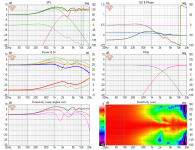
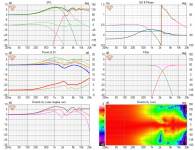
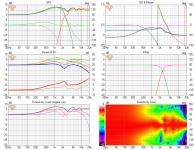
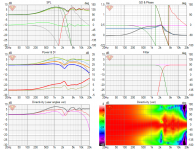

Then some asymmetric ones, BW3, Trifonov TP found in VCAD, and Harsch filter (BW24-LP@2500Hz, Bes12@2500Hz-HP,delay 1/4wl@2500Hz). They all seem to work well on balancing the reflections better. These all have anomalies near reference height so important to listen correct height.
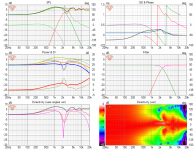
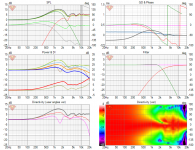
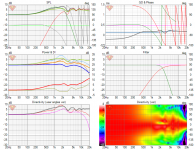
The Harsch xo is interesting, works fine on many respects including step response, except it gives more narrowing on the horizontal axis than LR12 and LR24 for example. 3rd order butterworh filter however gives wide horizontal response at xo.
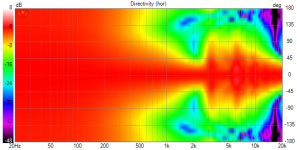
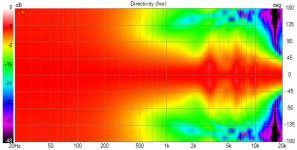 .
.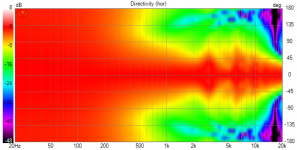
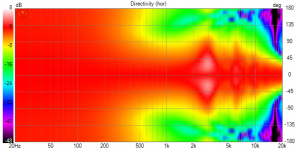
Here top contestants from the quick test, BW18 ideal filter on the example system standing straight vs. LR24 with with speaker tilted up 10 degrees.


It looks like the response for both are quite similar, especially if LR24 response dip was EQ:d some. Whole sixpacks:
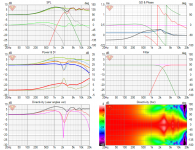
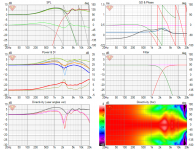
Note, the right bottom graph here shows horizontal response. Sixpacks at the beginning of this post show vertical response.





Then some asymmetric ones, BW3, Trifonov TP found in VCAD, and Harsch filter (BW24-LP@2500Hz, Bes12@2500Hz-HP,delay 1/4wl@2500Hz). They all seem to work well on balancing the reflections better. These all have anomalies near reference height so important to listen correct height.



The Harsch xo is interesting, works fine on many respects including step response, except it gives more narrowing on the horizontal axis than LR12 and LR24 for example. 3rd order butterworh filter however gives wide horizontal response at xo.

 .
.

Here top contestants from the quick test, BW18 ideal filter on the example system standing straight vs. LR24 with with speaker tilted up 10 degrees.


It looks like the response for both are quite similar, especially if LR24 response dip was EQ:d some. Whole sixpacks:


Note, the right bottom graph here shows horizontal response. Sixpacks at the beginning of this post show vertical response.
Last edited:
^oops, BW3 in the asymmetric
set is of course BW18 and its symmetric filter, both high and low pass are BW18 here. For some reason it works fine in the test, perhaps there is suitable delay in the filter for tweeter, so that response is tilted upwards.
Anyway, point of the above post was to test some typical target crossover filters we see talked about in forums. While any real world implementation probably differs from the ideal target responses I think these tests demonstrate that with symmetric vertical response we get different ceiling and floor bounce because angles towards the reflections are not symmetric. Nice theoretical symmetry in plans turns asymmetry for ear due to room (listening setup being closer to floor), and the opposite could happen, nasty looking asymmetric response could be nice for ear.
Some tilting back of the speaker or introducing some other asymmetry like filters or delays affects the spectral balance between floor and ceiling bounce. Whether these reflections are similar or not probably affects perceived sound image, or something. Tilting back your speaker might or might not help depending if its vertical response was symmetric or not.
ps.
Title of the thread is not too accurate, but its fine. Symmetric filters could have asymmetric vertical response if there was offset by delay or position like BW18. And I guess the opposite could happen too to some extent at least. Its the text book LR acoustic slopes that are symmetric in the sense of the thread title, that lead to symmetric vertical response. Symmetric vertical response is the key here, that makes floor and ceiling bounce differ.
set is of course BW18 and its symmetric filter, both high and low pass are BW18 here. For some reason it works fine in the test, perhaps there is suitable delay in the filter for tweeter, so that response is tilted upwards.
Anyway, point of the above post was to test some typical target crossover filters we see talked about in forums. While any real world implementation probably differs from the ideal target responses I think these tests demonstrate that with symmetric vertical response we get different ceiling and floor bounce because angles towards the reflections are not symmetric. Nice theoretical symmetry in plans turns asymmetry for ear due to room (listening setup being closer to floor), and the opposite could happen, nasty looking asymmetric response could be nice for ear.
Some tilting back of the speaker or introducing some other asymmetry like filters or delays affects the spectral balance between floor and ceiling bounce. Whether these reflections are similar or not probably affects perceived sound image, or something. Tilting back your speaker might or might not help depending if its vertical response was symmetric or not.
ps.
Title of the thread is not too accurate, but its fine. Symmetric filters could have asymmetric vertical response if there was offset by delay or position like BW18. And I guess the opposite could happen too to some extent at least. Its the text book LR acoustic slopes that are symmetric in the sense of the thread title, that lead to symmetric vertical response. Symmetric vertical response is the key here, that makes floor and ceiling bounce differ.
Forgot to post test with linear phase LR filters and it has the same phenomenon as non linear phase LR filters. So, some kind of rule of thumb might be that when phases track each other perfectly around crossover the resulting vertical response is symmetric. When they do not, like with BW18, or Harsch, there is asymmetry to vertical response.
To recap all the above into single practical info nugget:
A multiway speaker that has noncoincident tweeter and woofer and whose response is tweaked to max potential, nice anechoic graphs with smooth DI and nice tracking phase and all, might benefit small tilt back to actually make the intent happen when in room, in real listening situation, nice and symmetric response to ear.
To recap all the above into single practical info nugget:
A multiway speaker that has noncoincident tweeter and woofer and whose response is tweaked to max potential, nice anechoic graphs with smooth DI and nice tracking phase and all, might benefit small tilt back to actually make the intent happen when in room, in real listening situation, nice and symmetric response to ear.
Last edited:
I'm designing speakers so that the tweeter axis is lower than a shorter person sitting in a low chair. The speakers are on plates with adjustable feet for tilting the front with the purpose of making the tweeter perpendicular and on axis with any persons height sitting in most chair heights. The speakers are designed on tweeter axis.
This thread has got me thinking about reflections. Thanks!
This thread has got me thinking about reflections. Thanks!
Very interesting observation. I have a small 2-way which I designed two years ago for my workshop. My wife and I like to listen to music while we work. I found it sounds best when tilted back about 8 degrees.To recap all the above into single practical info nugget:
A multiway speaker that has noncoincident tweeter and woofer and whose response is tweaked to max potential, nice anechoic graphs with smooth DI and nice tracking phase and all, might benefit small tilt back to actually make the intent happen when in room, in real listening situation, nice and symmetric response to ear.
Attachments
Nice, thanks for comments!
Meanwhile did few quickie listening observations which are again biased as it was just casual tinkering and not a controlled test situation, but here it goes, take it as is.
When the vertical ER was aligned, no zig zag in graphs, there again seemed to be more focused image while at listening position, like in previous quick listening experiment. I got to mention I'm listening in mono, single prototype speaker, so not sure how this affects stereo and if "image" is right word here. With tweeter tilted (its modular speaker) I think I got more aware of ceiling reflection somehow so perhaps tilting isn't the best way to adjust the vertical ER reflection angles as now more highs above xo frequency gets to ceiling than without tilt.
Using only delay without physical tilt (mid has some delay in DSP, tweeter has a waveguide) to tilt the crossover lobes there seems to be the focusing but also perhaps some detail on midrange seemed to get lost, perhaps this got to do something the power dip around crossover seen on above sims, or just due to making the phase alignment worse which probably affects some harmonics or something. This keeps high frequencies toward ceiling same as before so no extra awareness for ceiling. Listening standing up (doing chores) felt bit weird, perhaps just due to fact that sound was bit different than before, not necessarily better or worse, just a change. Anyway, even if the mids felt more focused at listening position there was some side effects.
Then, tried elevating the whole speaker some to achieve similar effect, less zig zag. This one doesn't add too much highs toward ceiling either, while still affecting angles toward first vertical specular reflections. This seemed to sound better while standing up (doing chores) as well. This seems to be great option as it lifts the whole sound up, band on the stage, if thats something important. Also, if the design axis is now as close to ceiling as ear is floor listening distance doesn't matter the angles are always the same (as long as elevations stay the same). Not sure what my opinion is on all this elevated speaker sound and all, need more experiments and getting used to things, what I'm actually listening at. Anyway, elevating the whole speaker some felt an overall improvement for the system, what ever the reasons are, zig zag gets better but also many other things change, side effects.
Did another fun test while at it. Since the three way proto I have is modular I'm able to elevate each of the ways separately. Leaving bass on the ground and elevating mid and high using spacers was interesting. While adjusted crossover simulation did not show anything weird there was definitely now weird gap in spectrum when listening, highs and mids came up high and then there seemed to be some gap to low mids in perceived elevation of things, stretched unevenly somehow or something. This went better the more I raised the bass box as well (moved spacers from between bass and midhigh to below the bass) and best seemed to be when the whole speaker was elevated, no extra c-c between bass and mid, as designed. Not sure if this is something important but certainly was fun test and raised awarenes of possible audibilty of such things. Perhaps there is elevation of the ways that sounds better than the traditional one, tweeter at ear height and other ways below. Also there seems to be possibility to stretch sound vertically, in other words make spectrum stretch, highs come apparently higher up than mids and lows respectively. Not sure if this is good or bad thing, an effect nevertheless.
Well, all this might be just bogus or not relevant to others but certainly has been mucho fun with the hobby, exploring things for free! Hopefully this encourages all of you to do some listening tests with speaker tilt and height as well. Post your observations! 🙂
Meanwhile did few quickie listening observations which are again biased as it was just casual tinkering and not a controlled test situation, but here it goes, take it as is.
When the vertical ER was aligned, no zig zag in graphs, there again seemed to be more focused image while at listening position, like in previous quick listening experiment. I got to mention I'm listening in mono, single prototype speaker, so not sure how this affects stereo and if "image" is right word here. With tweeter tilted (its modular speaker) I think I got more aware of ceiling reflection somehow so perhaps tilting isn't the best way to adjust the vertical ER reflection angles as now more highs above xo frequency gets to ceiling than without tilt.
Using only delay without physical tilt (mid has some delay in DSP, tweeter has a waveguide) to tilt the crossover lobes there seems to be the focusing but also perhaps some detail on midrange seemed to get lost, perhaps this got to do something the power dip around crossover seen on above sims, or just due to making the phase alignment worse which probably affects some harmonics or something. This keeps high frequencies toward ceiling same as before so no extra awareness for ceiling. Listening standing up (doing chores) felt bit weird, perhaps just due to fact that sound was bit different than before, not necessarily better or worse, just a change. Anyway, even if the mids felt more focused at listening position there was some side effects.
Then, tried elevating the whole speaker some to achieve similar effect, less zig zag. This one doesn't add too much highs toward ceiling either, while still affecting angles toward first vertical specular reflections. This seemed to sound better while standing up (doing chores) as well. This seems to be great option as it lifts the whole sound up, band on the stage, if thats something important. Also, if the design axis is now as close to ceiling as ear is floor listening distance doesn't matter the angles are always the same (as long as elevations stay the same). Not sure what my opinion is on all this elevated speaker sound and all, need more experiments and getting used to things, what I'm actually listening at. Anyway, elevating the whole speaker some felt an overall improvement for the system, what ever the reasons are, zig zag gets better but also many other things change, side effects.
Did another fun test while at it. Since the three way proto I have is modular I'm able to elevate each of the ways separately. Leaving bass on the ground and elevating mid and high using spacers was interesting. While adjusted crossover simulation did not show anything weird there was definitely now weird gap in spectrum when listening, highs and mids came up high and then there seemed to be some gap to low mids in perceived elevation of things, stretched unevenly somehow or something. This went better the more I raised the bass box as well (moved spacers from between bass and midhigh to below the bass) and best seemed to be when the whole speaker was elevated, no extra c-c between bass and mid, as designed. Not sure if this is something important but certainly was fun test and raised awarenes of possible audibilty of such things. Perhaps there is elevation of the ways that sounds better than the traditional one, tweeter at ear height and other ways below. Also there seems to be possibility to stretch sound vertically, in other words make spectrum stretch, highs come apparently higher up than mids and lows respectively. Not sure if this is good or bad thing, an effect nevertheless.
Well, all this might be just bogus or not relevant to others but certainly has been mucho fun with the hobby, exploring things for free! Hopefully this encourages all of you to do some listening tests with speaker tilt and height as well. Post your observations! 🙂
Last edited:
Is what you are hearing not so much the tilt and changed FR due to non perfect directivity, but rather the increased amount of ceiling contribution to the direct sound?
//
//
will do, not sure when there is time as holidays are almost over and kids make so much noise its impossoble to do critical listening 😀Try separating the mid and tweeter too, and let us know what you hear
Many things happen with physical tilt and tilting with phase/crossover or elevating speaker without either tilt, all have different set of "side effects" and one common thing is aligning respobse towards the vertical first reflections. Its hard to say what is better if any, with quick tests. There isnt too much prior talk on this. At least havent bumped on any resently.Is what you are hearing not so much the tilt and changed FR due to non perfect directivity, but rather the increased amount of ceiling contribution to the direct sound?
One of the most consistent "tropes" in Stereophile is that writers lament how the newest speakers from Wilson aren't as good as the original Watt / Puppy, and they're also way more expensive.
%20and%202018%20Sasha%20DAW%20(right).jpg)
Wilson Watt Puppy on the left, Wilson Sasha on the right
I heard the Watt Puppy at CES about two decades back and thought it sounded way better than the sum of it's parts.
I was using Vandersteen 2CEs for my reference speaker for about four years. Both the 2CE and the Treo feature a sloped baffle. I was never really "thrilled" with the dynamic performance or tonality of the 2CE, and the measurements over at erinsaudiocorner confirm it has some issues. (https://www.erinsaudiocorner.com/loudspeakers/vandersteen_model_2/) But I was really surprised that the Treo actually sounded a little worse than the 2CE, despite costing 300% more!
My "hunch" is that the diffraction treatment on the 2CE is making an audible difference in the imaging, and that the "lip" on the midrange and the tweeter of the Treo is screwing up the imaging.
The 2CE images really nice and I can see why it's become a fan favorite for soundstaging. But it's dynamics are AWOL and I'm into dynamics.
TLDR: a bunch of speakers that I've listened to which have a sloped front baffle seem to consistently image really well.
%20and%202018%20Sasha%20DAW%20(right).jpg)
Wilson Watt Puppy on the left, Wilson Sasha on the right
I heard the Watt Puppy at CES about two decades back and thought it sounded way better than the sum of it's parts.
I was using Vandersteen 2CEs for my reference speaker for about four years. Both the 2CE and the Treo feature a sloped baffle. I was never really "thrilled" with the dynamic performance or tonality of the 2CE, and the measurements over at erinsaudiocorner confirm it has some issues. (https://www.erinsaudiocorner.com/loudspeakers/vandersteen_model_2/) But I was really surprised that the Treo actually sounded a little worse than the 2CE, despite costing 300% more!
My "hunch" is that the diffraction treatment on the 2CE is making an audible difference in the imaging, and that the "lip" on the midrange and the tweeter of the Treo is screwing up the imaging.
The 2CE images really nice and I can see why it's become a fan favorite for soundstaging. But it's dynamics are AWOL and I'm into dynamics.
TLDR: a bunch of speakers that I've listened to which have a sloped front baffle seem to consistently image really well.
Attachments
Got a thought, that on a multiway speaker with stacked ways there is path length difference of all the ways that differ and give out its physical location, perhaps. Then, if the path length differences of vertical first reflections of a tweeter and a woofer of a multiway speaker vary only 1/4wl then the reflections are seemingly at same location, right? Quick calc estimates that 10cm c-c in 250cm high room and 3m listening distance says the pathlengths through floor and ceiling vary within roughly 7cm when tweeter is at ear height and woofer below. So 28cm wavelength is about 1.2kHz, crossover here and ceiling and floor reflections should be similar for both drivers (assuming both have similar off axis response) and this would be effectively a point source? With 15cm c-c reflection path lengths would vary about 10cm, or xo down to 850Hz already.
The common point source rule of thumb is c-c 1/4wl at crossover, here it would have been 10cm so 40 cm which is ~850Hz. Hmm, we can get away with slightly longer c-c, about 50% up on frequency or roughly 30% off from wavelength, in the two example calculations above, to still be point source enough? the relief is quite big, but still out of reach, kind of 🙂 too late evening to get further. Edit I guess my math is bad, gotta try again tomorrow
The common point source rule of thumb is c-c 1/4wl at crossover, here it would have been 10cm so 40 cm which is ~850Hz. Hmm, we can get away with slightly longer c-c, about 50% up on frequency or roughly 30% off from wavelength, in the two example calculations above, to still be point source enough? the relief is quite big, but still out of reach, kind of 🙂 too late evening to get further. Edit I guess my math is bad, gotta try again tomorrow
Last edited:
Example based on the above, if we have speaker like in first post with crossover around 2500Hz (~14cm), the 1/4wl rule would have c-c distance only ~3,5cm to make the system point source. With the relaxed distance, where the first vertical reflections for both transducers would still be within 1/4wl would be roughly 2500 * 0.7 = 1750 so roughly 20cm and quarter of that ~5cm. Or just directly roughly 1/3wl of the crossover frequency. Still out of reach with real word drivers.
What about if listening distance is something else than 3m? Max path length difference between drivers to each boundary happens directly above and below, 90 degree vertical off axis, max is c-c of drivers. If listening distance is shorter than 3m as used in examples above angles towards first ceiling and floor specular reflections increase and path length difference is getting closer to c-c. Conversely if listening distance is increased angles get smaller and path length differences get shorter than c-c.
Also, when the drivers are roughly at listening height the path length differences of both drivers to both vertical boundaries vary less than if the speaker was elevated, meaning that if a speaker is elevated the "effective" c-c goes further out from being a point source, if that means anything, speaker is most point source in regards of first vertical reflections when its roughly ear height. Speaker above head and tilted down would make path length difference through ceiling even longer between the drivers, shorter through floor. Opposite happens if speaker is lowered (ear height or below) and tilted up. Since ceiling is further away than floor, tilting speaker up would make the reflection wee bit more point source like as now path length difference of drivers through floor would increase and through ceiling they would decrease equalizing the distances some, in other words make the speaker wee bit more point source.
Say we have tweeter and woofer as close as possible physically, roughly 3/4wl c-c at crossover. To make this system approach point source we could rotate the system some, tilt speaker 45 degrees on its side and now we have almost halved vertical 3/4wl, its now almost 1/3wl (well, not) and perhaps point source in respect to ceiling and floor reflections. Of course now the poo vertical pattern due to crossover is also affecting to our nice horizontal pattern making things perhaps worse again in other respects. 45 degree tilt would make path length difference appear on the lateral reflections as well but the side wall reflections might be at similar angle as ceiling reflection, or less, which means also the lateral reflections are still within 1/4wl path length difference between the drivers and effectively point source. Anyway, something to experiment at some day.
So perhaps if there is anything useful to be extracted from this thought experiment its that for near field listening
What about if listening distance is something else than 3m? Max path length difference between drivers to each boundary happens directly above and below, 90 degree vertical off axis, max is c-c of drivers. If listening distance is shorter than 3m as used in examples above angles towards first ceiling and floor specular reflections increase and path length difference is getting closer to c-c. Conversely if listening distance is increased angles get smaller and path length differences get shorter than c-c.
Also, when the drivers are roughly at listening height the path length differences of both drivers to both vertical boundaries vary less than if the speaker was elevated, meaning that if a speaker is elevated the "effective" c-c goes further out from being a point source, if that means anything, speaker is most point source in regards of first vertical reflections when its roughly ear height. Speaker above head and tilted down would make path length difference through ceiling even longer between the drivers, shorter through floor. Opposite happens if speaker is lowered (ear height or below) and tilted up. Since ceiling is further away than floor, tilting speaker up would make the reflection wee bit more point source like as now path length difference of drivers through floor would increase and through ceiling they would decrease equalizing the distances some, in other words make the speaker wee bit more point source.
Say we have tweeter and woofer as close as possible physically, roughly 3/4wl c-c at crossover. To make this system approach point source we could rotate the system some, tilt speaker 45 degrees on its side and now we have almost halved vertical 3/4wl, its now almost 1/3wl (well, not) and perhaps point source in respect to ceiling and floor reflections. Of course now the poo vertical pattern due to crossover is also affecting to our nice horizontal pattern making things perhaps worse again in other respects. 45 degree tilt would make path length difference appear on the lateral reflections as well but the side wall reflections might be at similar angle as ceiling reflection, or less, which means also the lateral reflections are still within 1/4wl path length difference between the drivers and effectively point source. Anyway, something to experiment at some day.
So perhaps if there is anything useful to be extracted from this thought experiment its that for near field listening
Last edited:
Alright here is data for the above, if tweeter and woofer were stacked one above the other it would need tweeter to be moved 60 degrees on the baffle in respect to woofer to halve the c-c on vertical axis. Or tilt the speaker that has stacked tweeter and woofer 60 degrees to its side. This would increase c-c on horizontal axis and lateral early reflections and listening window would be affected. With 45 degree tilt c-c would reduce only to ~7cm vertically in the example where actual c-c is 10cm and it wouldn't yet be a point source towards ceiling with the example 2.5kHz xo. Making the tilt to side, or offset the tweeter, is a way to try and make compromise between (hopefully) very good horizontal pattern and somewhat worse vertical pattern. Basically what happens is vertical and horizontal listening planes get more similar off-axis response from the speaker. Listening axis and speaker height on these examples is between tweeter and woofer, so the normal height about every system has.
Look at the harsh crossover now, narrow(er) horizontal response (lobe) is not so bad anymore, to one side.
BW18 filter, with tweeter moved on baffle from above woofer, to 30 degrees, to 45 degrees and to 60 degrees keeping 10cm c-c all the time. Look how vertical reflections get smoother and horizontal response degrades. Polar map lower right corner shows normalized horizontal response. Vertical response (reflections) are about what it would be with point source! But I suspect the worse lateral reflections would make sound/image worse.
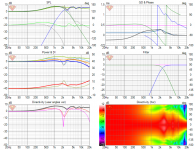
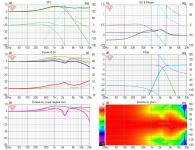
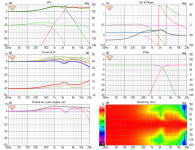
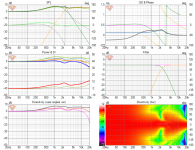
With LR24 filters, lateral response to one side gets better and the vertical reflection zig zag is gone even with 30 degree rotation of tweeter. Should make beter sound!?🙂
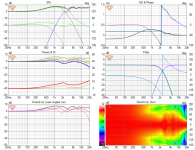
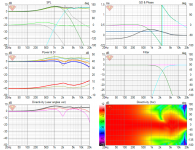
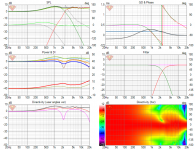
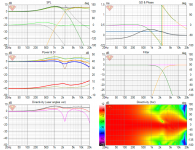
Harsch
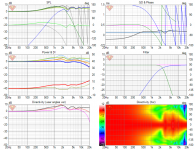
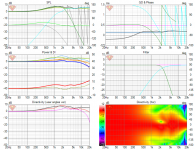
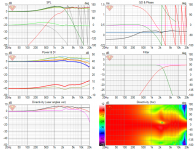
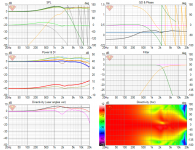
In these sims the tweeter is rotated clock wise so a bit right from woofer. This means that the simulated system would work better either left or right side on a stereo setup depending on toe-in. If toe-in is out from ear, speakers on-axis is between ear and nearest sidewall, then perhaps these won't work that well as ear or side wall would get different response. But if listening on-axis or with heavy toe-in like on a roughly constant narrow directivity system with 45 degree toe-in, crossing front of listening position, both the listener and nearest sidewall are on the same side and this might work fine. Would look weird though. Note, tweeter is on the right, but the speaker would work on the left side of stereo setup as polar response to left is smoother than to right, tilted inward towards center and not outward towards walls. This is counter intuitive, usually tweeter is on the outside as it seems logical for "wider stereo" but it makes worse polar response towards important angles according to the sims above. Interesting stuff 🙂
Look at the harsh crossover now, narrow(er) horizontal response (lobe) is not so bad anymore, to one side.
BW18 filter, with tweeter moved on baffle from above woofer, to 30 degrees, to 45 degrees and to 60 degrees keeping 10cm c-c all the time. Look how vertical reflections get smoother and horizontal response degrades. Polar map lower right corner shows normalized horizontal response. Vertical response (reflections) are about what it would be with point source! But I suspect the worse lateral reflections would make sound/image worse.




With LR24 filters, lateral response to one side gets better and the vertical reflection zig zag is gone even with 30 degree rotation of tweeter. Should make beter sound!?🙂




Harsch




In these sims the tweeter is rotated clock wise so a bit right from woofer. This means that the simulated system would work better either left or right side on a stereo setup depending on toe-in. If toe-in is out from ear, speakers on-axis is between ear and nearest sidewall, then perhaps these won't work that well as ear or side wall would get different response. But if listening on-axis or with heavy toe-in like on a roughly constant narrow directivity system with 45 degree toe-in, crossing front of listening position, both the listener and nearest sidewall are on the same side and this might work fine. Would look weird though. Note, tweeter is on the right, but the speaker would work on the left side of stereo setup as polar response to left is smoother than to right, tilted inward towards center and not outward towards walls. This is counter intuitive, usually tweeter is on the outside as it seems logical for "wider stereo" but it makes worse polar response towards important angles according to the sims above. Interesting stuff 🙂
Last edited:
To recap, side-effects of the first posts that used tilt and / or delay and even elevation to make the vertical responses alike relative to each other at listening position had side-effects that weren't too welcome outlined on the early posts, at least with single speaker mono listening, quick sighted tinkerin experiments with high possibility for bias. It was stated by me that this is mostly problem with crossovers that have phase tracking, in other words symmetrical vertical lobing like LR crossovers, which makes asymmetric response at listening position because we and our systems are closer to floor than to ceiling.
On the sims posted in previous post we see that LR24 vertical reflection zig zag response, the original problem, was solved by simply tilting the speaker on its side a bit, 30 degrees seem to be enough, perhaps even less would work, to tighten up single speaker mono "imaging", if that is a thing. From the simulations I assume also lateral reflections improve, at least should not degrade too bad if toe-in is toward ear or crossing in front of listening position. This asymmetry could be utilized to lower IACC which should improve spaciousness as well. This would mean there is no (bad) side effects to this arrangement, at least in theory, it would make more sense to tilt speakers inward to their side than tilt them up 🙂 Enjoy good sound of LR filters while vertical reflections were equalized to each other and even lateral reflections got better, close wall reflection more alike to on-axis and the opposing wall further off lowering IACC.
The above system, vertical reflections are best with BW18 and Harsch filters if the speaker is straight up like usual. On LR and perhaps Harsch filters response could be bettered by tilting the speakers inward on their sides some instead of tilting them up, unless toe-in is between nearest sidewall and ear then perhaps this would make things worse.
Alright, hopefully got my thoughts now out on this without too much error. I'd be glad if someone tried these and then reported if there is anything to it.
On the sims posted in previous post we see that LR24 vertical reflection zig zag response, the original problem, was solved by simply tilting the speaker on its side a bit, 30 degrees seem to be enough, perhaps even less would work, to tighten up single speaker mono "imaging", if that is a thing. From the simulations I assume also lateral reflections improve, at least should not degrade too bad if toe-in is toward ear or crossing in front of listening position. This asymmetry could be utilized to lower IACC which should improve spaciousness as well. This would mean there is no (bad) side effects to this arrangement, at least in theory, it would make more sense to tilt speakers inward to their side than tilt them up 🙂 Enjoy good sound of LR filters while vertical reflections were equalized to each other and even lateral reflections got better, close wall reflection more alike to on-axis and the opposing wall further off lowering IACC.
The above system, vertical reflections are best with BW18 and Harsch filters if the speaker is straight up like usual. On LR and perhaps Harsch filters response could be bettered by tilting the speakers inward on their sides some instead of tilting them up, unless toe-in is between nearest sidewall and ear then perhaps this would make things worse.
Alright, hopefully got my thoughts now out on this without too much error. I'd be glad if someone tried these and then reported if there is anything to it.
Last edited:
One more perspective, example system with LR24 filters. Assuming 3m spacing 60 degree equilateral listening triangle so speaker is toed in 30 degrees straight to ear, listening on-axis. This would make close side wall reflection roughly -80 degrees to the speaker and opposing sidewall to 40 degrees to the speaker for 5m wide room. Here is vertical reflection calculator exploited to get the angles.
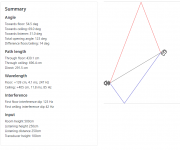
No inward tilt with the speaker, tweeter and woofer above each other. Response to near wall (red) differs from direct sound (black) more than that on the opposing wall (cyan). Second image shows responses to vertical reflections, zig zag.

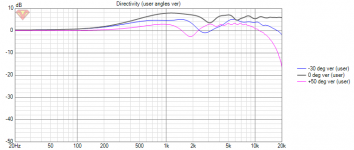
With tilting speaker inwards 30 degrees now the close wall response is closer to direct sound response and far away wall is less so making lower IACC. This should yield more spacious sound while perhaps widening the image as the close wall reflection is "improved" if I'm simulating correctly. Also the vertical reflections don't have the zig zag anymore making perhaps focus to midrange as speculated in first post, well not sure if this is worse or better or does it matter. At least the floor reflection is again very alike to direct sound, just like the near side wall reflection is.
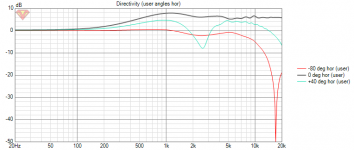
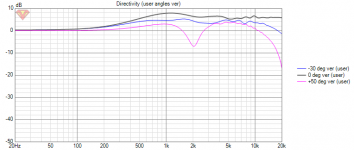
Note, levels on the graphs show level at equal distance. In reality the red close wall reflection would be louder and opposing wall would be quieter due to opposing wall having much longer path length and thus more attenuation.
So, if you have speaker with symmetric vertical response, try tilting them inwards and toe-in more than you have used to, for perhaps better sound 😉

No inward tilt with the speaker, tweeter and woofer above each other. Response to near wall (red) differs from direct sound (black) more than that on the opposing wall (cyan). Second image shows responses to vertical reflections, zig zag.


With tilting speaker inwards 30 degrees now the close wall response is closer to direct sound response and far away wall is less so making lower IACC. This should yield more spacious sound while perhaps widening the image as the close wall reflection is "improved" if I'm simulating correctly. Also the vertical reflections don't have the zig zag anymore making perhaps focus to midrange as speculated in first post, well not sure if this is worse or better or does it matter. At least the floor reflection is again very alike to direct sound, just like the near side wall reflection is.


Note, levels on the graphs show level at equal distance. In reality the red close wall reflection would be louder and opposing wall would be quieter due to opposing wall having much longer path length and thus more attenuation.
So, if you have speaker with symmetric vertical response, try tilting them inwards and toe-in more than you have used to, for perhaps better sound 😉
Last edited:
And just for completeness sake opened some simulation of my current setup, not sure if this is whats in the DSP currently. Anyway, here tilting the speaker to side doesn't seem to make mucho difference, slopes between mid and high are not symmetric. Lowered IACC happens in this case with outward tilt at least with this heavy toe in of roughly 40 degrees so -10 degree listening angle. Angles towards horizontal reflections are at speaker off-axis angles -90 and 30. Vertical zig zag is already fixed by making vertical response asymmetric adjusting delay between mid and tweeter, not much affected here with tilt as c-c is much more (~1wl) than on the previous sims with example two way system.
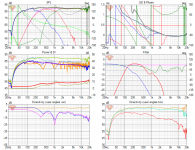
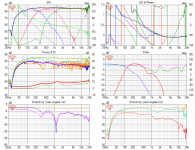
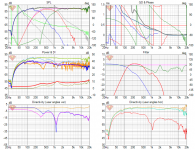
If toe in was only 20 degrees instead, between ear and close wall then the angles towards first laterel reflection poins in terms of speaker dispersion would be equal roughly 60 degrees either side, from speakers on-axis, in our 5m wide room with 3m listening triangle.
Here the IACC lowers some which could increase spaciousness again but makes sweetspot smaller, something that I haven't explicitly mentioned on previous examples how toe in affects it.
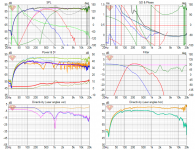
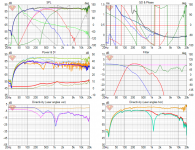
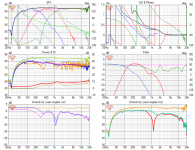
Anyway, some data that the stuff isn't all that obvious and I have no idea what implications of perceived sound is. All these sims demonstrate that it is possible to manipulate both vertical and horizontal responses quite much so that in room sound is affected and perhaps more favored by hearing system, first vertical and lateral reflections responses change. Depending on the system directivity and crossover topology there might be benefit tilting the speaker on its side some, experiment with toe-in. Especially with LR crossover and physically tight c-c spacing it might be possible to improve imaging by tilting speakers on their sides (inwards). Opposite tilt could help with some other topology like the above. Although if speaker has controlled directivity and big sweetspot toe in it doesn't seem to benefit mucho. For single listening position with slight or no toe-in position slight outward tilt seems that it could be of use decreasing IACC some, which should make more spacious sound.
Well, all this is few sims so might not apply to all situations or be outright wrong if there is a mistake somewhere so take all this as motivation to experiment how sound changes with your speakers in your listening setup, can you make improvement? Nevertheless fun stuff to think about 🙂



If toe in was only 20 degrees instead, between ear and close wall then the angles towards first laterel reflection poins in terms of speaker dispersion would be equal roughly 60 degrees either side, from speakers on-axis, in our 5m wide room with 3m listening triangle.
Here the IACC lowers some which could increase spaciousness again but makes sweetspot smaller, something that I haven't explicitly mentioned on previous examples how toe in affects it.



Anyway, some data that the stuff isn't all that obvious and I have no idea what implications of perceived sound is. All these sims demonstrate that it is possible to manipulate both vertical and horizontal responses quite much so that in room sound is affected and perhaps more favored by hearing system, first vertical and lateral reflections responses change. Depending on the system directivity and crossover topology there might be benefit tilting the speaker on its side some, experiment with toe-in. Especially with LR crossover and physically tight c-c spacing it might be possible to improve imaging by tilting speakers on their sides (inwards). Opposite tilt could help with some other topology like the above. Although if speaker has controlled directivity and big sweetspot toe in it doesn't seem to benefit mucho. For single listening position with slight or no toe-in position slight outward tilt seems that it could be of use decreasing IACC some, which should make more spacious sound.
Well, all this is few sims so might not apply to all situations or be outright wrong if there is a mistake somewhere so take all this as motivation to experiment how sound changes with your speakers in your listening setup, can you make improvement? Nevertheless fun stuff to think about 🙂
I believe alot of what you describe are the combined effects of off axis HF combing with diffracting components. Any time you're not on axis with the tweeter, you're going to see some amount of the above mentioned, including the tweeter's off axis FR quirks, which get worse with a bigger baffle that hasn't been optimized to minimize diffraction.
I always design the tweeter to be on axis with ears in sitting position without tilt. I never point the entire speaker (or any combination of its drivers) more than 5 degrees up. Past that point you'll see increase ceiling bounce with a longer room. Also, the reflection of vertical baffle diffraction components into the listening area by itself creates its own FR signature that worsens in severity the further you move the listening axis upwards (downward speaker tilt), which is why i never mount speakers firing downwards close to the ceiling. It simply doesn't sound right and also creates a weird stereo image in the veritcal plane. The obvious exception to this rule is PA speakers, which often have to be placed that way for many other logical reasons, but a home hifi situation is different in its own set of requirements.
I always design the tweeter to be on axis with ears in sitting position without tilt. I never point the entire speaker (or any combination of its drivers) more than 5 degrees up. Past that point you'll see increase ceiling bounce with a longer room. Also, the reflection of vertical baffle diffraction components into the listening area by itself creates its own FR signature that worsens in severity the further you move the listening axis upwards (downward speaker tilt), which is why i never mount speakers firing downwards close to the ceiling. It simply doesn't sound right and also creates a weird stereo image in the veritcal plane. The obvious exception to this rule is PA speakers, which often have to be placed that way for many other logical reasons, but a home hifi situation is different in its own set of requirements.
I should add that the listening experiments I did are with relatively low diffraction speaker, responses visible above. edit. the above post responses don't show diffraction much so here stereophile style graph to illustrate.
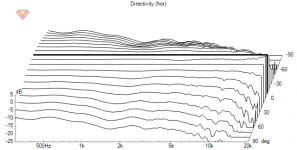
Here is the two way simulation I've been using in this thread, generated with VCAD diffraction tool using ideal drivers.
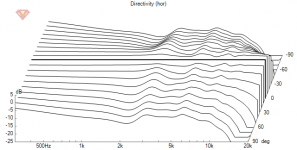
And here for kicks some stereophile measured speaker for good amount of diffraction 😀
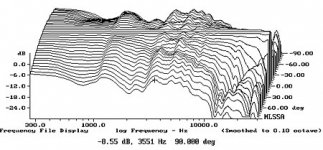
Simulation of the example two way speaker I have used in this thread has bad diffraction, but it wasn't the point in these experiment, effects are included in the graphs (response to any angle is combination of ideal driver direct sound augmented with simple baffle edge diffraction, made with vituixcad diffraction tool). I think you are right the diffraction could be very important in all this, perceived quality with elevation and tilts and all. With typical rectangular baffle tilting the speaker would spread out diffraction in vertical and horizontal planes especially if the tilt is sideways (and not up) as the edges would not be parallel to first reflection paths any more and perhaps even make things better.
I have no idea how stereo image perception is affected, I have only single speaker mono to listen to and these simulations to speculate on. I've just recently learned there is phantom image elevation happening, perhaps reason elevating speaker doesn't work that well as you have found out. Also tilting speaker downwards is not good thing, it makes the floor and ceiling reflection even more out from each other perhaps ping pointing any issues in the vertical response. Tilting up also had side-effects as increased HF towards ceiling. All is relative to the acoustic output of the speaker, crossovers affect also c-c spacing, diffraction.. Perhaps some speakers work better elevated than others, perhaps any speaker works best about at ear height as they typically are. Anyway, trying to bring out effects what happens when speaker is in room, positioned relative to boundaries and listening position.
Have you experimented with the sideways tilt?

Here is the two way simulation I've been using in this thread, generated with VCAD diffraction tool using ideal drivers.

And here for kicks some stereophile measured speaker for good amount of diffraction 😀

Simulation of the example two way speaker I have used in this thread has bad diffraction, but it wasn't the point in these experiment, effects are included in the graphs (response to any angle is combination of ideal driver direct sound augmented with simple baffle edge diffraction, made with vituixcad diffraction tool). I think you are right the diffraction could be very important in all this, perceived quality with elevation and tilts and all. With typical rectangular baffle tilting the speaker would spread out diffraction in vertical and horizontal planes especially if the tilt is sideways (and not up) as the edges would not be parallel to first reflection paths any more and perhaps even make things better.
I have no idea how stereo image perception is affected, I have only single speaker mono to listen to and these simulations to speculate on. I've just recently learned there is phantom image elevation happening, perhaps reason elevating speaker doesn't work that well as you have found out. Also tilting speaker downwards is not good thing, it makes the floor and ceiling reflection even more out from each other perhaps ping pointing any issues in the vertical response. Tilting up also had side-effects as increased HF towards ceiling. All is relative to the acoustic output of the speaker, crossovers affect also c-c spacing, diffraction.. Perhaps some speakers work better elevated than others, perhaps any speaker works best about at ear height as they typically are. Anyway, trying to bring out effects what happens when speaker is in room, positioned relative to boundaries and listening position.
Have you experimented with the sideways tilt?
Last edited:
Interesting thread sofar. My living room has concrete walls floor and ceiling, (and is asymetric).
Am on a short holiday and forgot to taken my laptop with me. So no pictures. My speakers (wwmt) are tilted 5 degrees. It has 2 8" woofers, C2C is ~ 30 cm. With LP at 99cm high and 307 cm away the lowest woofer is still a few centimeter later, result is a slightly downtilted low-mid frequency "lobe".
If i understand your thread thusfar it is not bad at all.
Am on a short holiday and forgot to taken my laptop with me. So no pictures. My speakers (wwmt) are tilted 5 degrees. It has 2 8" woofers, C2C is ~ 30 cm. With LP at 99cm high and 307 cm away the lowest woofer is still a few centimeter later, result is a slightly downtilted low-mid frequency "lobe".
If i understand your thread thusfar it is not bad at all.
- Home
- Loudspeakers
- Multi-Way
- Vertical reflections, symmetric crossover and tilt -experiment


